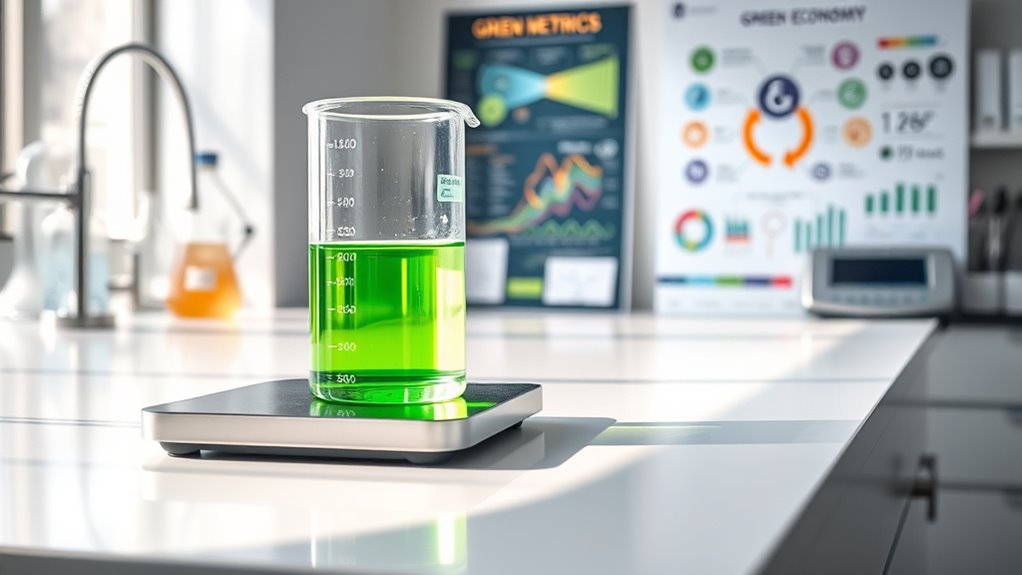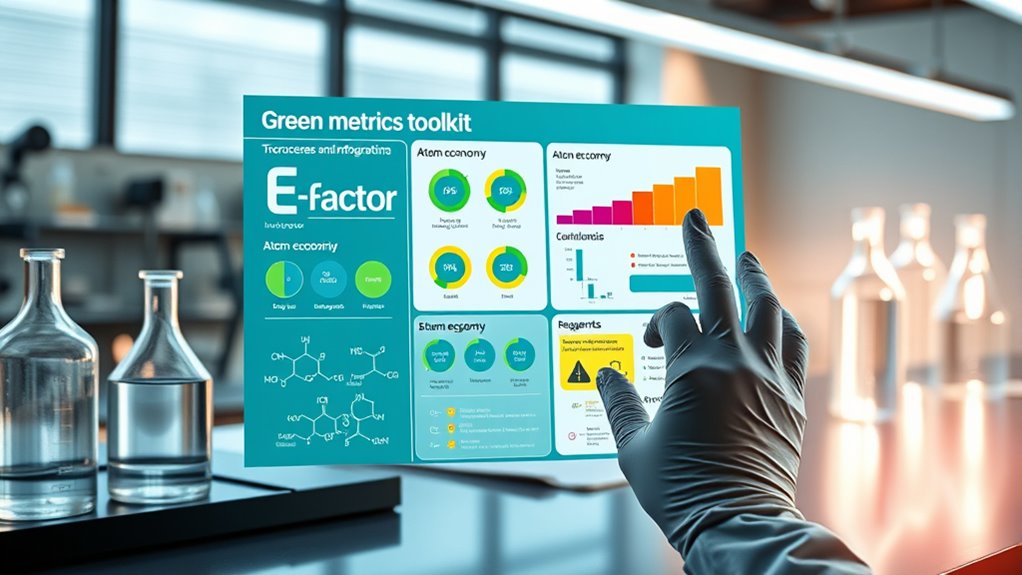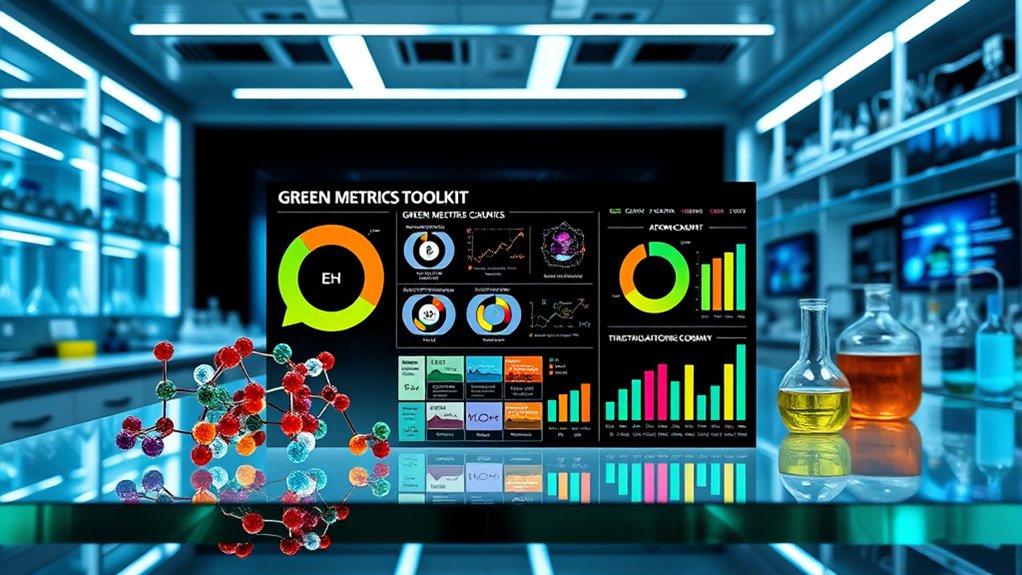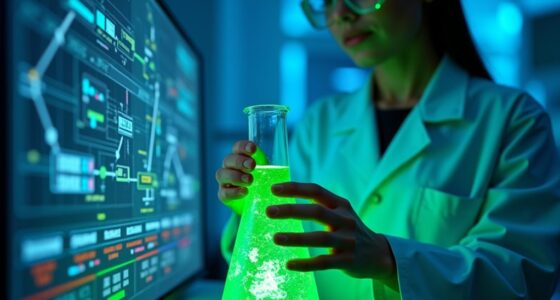The Green Metrics Toolkit helps you evaluate and improve the sustainability of chemical processes using various tools like the E-factor, atom economy, and the CHEM21 framework. These metrics measure waste, efficiency, and environmental impact, guiding you toward greener choices. While the E-factor focuses on waste-to-product ratios, atom economy highlights atom utilization, and the CHEM21 offers a step-by-step assessment. Continuing onward will give you a clearer understanding of each metric’s role and how to apply them effectively.
Key Takeaways
- The Green Metrics Toolkit evaluates sustainability using quantitative measures like E-Factor and Atom Economy for process efficiency.
- E-Factor measures waste generated per product, highlighting waste reduction opportunities but ignores waste toxicity.
- Atom Economy assesses how effectively reactant atoms convert into desired products, promoting resource efficiency.
- The CHEM21 Toolkit offers a structured, multi-criteria assessment from laboratory to industrial scale, including qualitative and quantitative metrics.
- Advanced metrics like OE and RP incorporate lifecycle, safety, and environmental impacts for comprehensive sustainability evaluation.
Understanding the Foundations of Green Metrics

Green metrics are essential tools that quantify how chemical processes impact the environment. They provide objective measures to evaluate sustainability and help you identify greener alternatives. These metrics allow you to benchmark your processes against industry standards or advanced techniques, guiding improvements. Incorporating waste reduction strategies enhances the overall effectiveness of green metrics by addressing not only resource use but also waste management.
They cover multiple sustainability aspects, including waste generation, energy use, and toxicity, enabling all-encompassing assessments. Different categories exist, such as mass-based metrics like Atom Economy, which focus on resource efficiency, and energy metrics that evaluate energy consumption.
Combining qualitative and quantitative data forms holistic toolkits for a complete sustainability profile. Automated tools simplify calculations, improve accuracy, and support continuous monitoring. Additionally, understanding the environmental and health impacts of traditional practices like wood-burning can inform the development of more sustainable and environmentally friendly alternatives.
The Role and Limitations of E-Factor in Sustainable Chemistry

The E-Factor serves as a key metric for evaluating waste generation in chemical processes by calculating the ratio of total waste mass to the desired product mass. It includes waste byproducts, leftover reactants, solvent losses, spent catalysts, and catalyst supports. This metric highlights environmental concerns related to waste and promotes greener practices. Since its introduction in 1992, it has helped identify inefficient processes and encouraged waste reduction. However, the E-Factor has limitations. It’s a simplistic measure that focuses solely on mass, ignoring waste toxicity or recyclability. Definitions of waste can vary across processes, leading to potential misinterpretation. To fully assess sustainability, it should be used alongside other metrics like atom economy or life cycle assessments. Additionally, compatibility factors from the zodiac or personality insights can inspire more innovative and environmentally conscious approaches to chemical design and waste management. Moreover, integrating automated data analysis can enhance the accuracy and efficiency of waste evaluation. Despite its flaws, the E-Factor remains a valuable tool for promoting greener chemistry.
Atom Economy: Principles and Practical Applications

Atom economy is a fundamental principle in sustainable chemistry that measures how efficiently a chemical reaction incorporates reactant atoms into the final product. Developed by Barry Trost in the 1990s, it’s a core metric to evaluate reaction efficiency without considering yield. High reaction efficiency can be achieved by maximizing atom economy, which reduces waste and improves sustainability. The formula is: (FW of desired product / FW of all reactants) × 100%. For example, a rearrangement reaction achieving 100% atom economy uses all reactant atoms, while synthesis of bromobutane has about 50%. Practical applications include reducing waste in pharmaceutical syntheses, optimizing processes, and developing catalysts that minimize non-incorporated reagents. Although it doesn’t account for energy or toxicity, atom economy helps identify greener routes early, conserve resources, and align with green chemistry principles, ultimately leading to cost savings and less environmental impact.
The CHEM21 Toolkit: A Stepwise Approach to Green Assessment

Building on the concept of measuring reaction efficiency, the CHEM21 Toolkit offers a practical, step-by-step method to evaluate the sustainability of chemical processes. It’s structured in ‘passes’ that guide you from bench-scale experiments to industrial applications, increasing complexity at each stage.
The toolkit combines qualitative and quantitative criteria, providing a holistic view that extends beyond simple mass-based metrics. Using an accessible Excel format, it enables you to benchmark reactions against current standards, pinpointing high performers and areas needing improvement.
Key metrics like optimum efficiency, renewable percentage, and waste percentage are evaluated alongside parameters such as energy use, catalyst recycling, and raw material sourcing. This multi-parameter approach helps you identify opportunities for greener reaction design, integrating environmental, health, and societal impacts into your assessment. This comprehensive approach ensures a thorough evaluation of the environmental and economic aspects of chemical reactions. Additionally, incorporating sustainable materials into process design can further enhance overall greenness and reduce ecological footprints. Emphasizing life cycle analysis can provide deeper insights into the total environmental impact of chemical processes, supporting more sustainable decision-making.
Introducing Innovative Metrics for Enhanced Sustainability Evaluation

Innovative metrics like Optimum Efficiency (OE), Renewable Percentage (RP), and Waste Percentage (WP) are transforming how you quantify reaction sustainability beyond traditional mass-based measures. These metrics assess not only quantitative data like waste and energy use but also qualitative factors such as health, safety, and environmental impact. Real couples often demonstrate how shared experiences and communication contribute to relationship success, highlighting the importance of comprehensive evaluation—an approach that can be applied to sustainability metrics as well. They incorporate lifecycle considerations, accounting for upstream and downstream effects, making evaluations more all-encompassing. Designed to be scalable, they work from small bench-scale to industrial processes, ensuring broad applicability. The color-coded flag system—green, amber, red—provides an immediate visual cue of sustainability status, helping you identify areas needing improvement. By integrating these innovative metrics, you gain a holistic view of reaction sustainability, fostering smarter choices and continuous process optimization.
Leveraging Green Metrics for Better Decision-Making and Education

Leveraging green metrics transforms decision-making and education by providing clear, data-driven insights into sustainability performance. With real-time data from digital smart meters, you can identify inefficiencies and prioritize waste reduction in schools.
Metrics like CO2 emissions per pupil, waste diversion rates, and water or energy use enable you to compare performance against national benchmarks such as CIBSE and DEC reports. Regular carbon footprint assessments help target underperforming areas and optimize sustainability investments.
Integrating data literacy programs for educators supports the adoption of sustainable practices, while transparent reporting maintains ongoing progress.
Using environmental impact metrics in curricula—like life cycle assessments—helps students develop practical skills for sustainability decisions.
Frequently Asked Questions
How Do Green Metrics Influence Industrial Process Development?
Green metrics influence your process development by guiding you to minimize waste, energy use, and hazardous materials. They help you identify inefficiencies and prioritize improvements, like optimizing reaction steps or recovering solvents.
You can compare different methods, align with regulations, and reduce costs. By integrating these metrics, you make smarter decisions that lead to more sustainable, compliant, and economically viable processes, ultimately advancing your environmental and business goals.
Can Green Metrics Be Integrated Into Existing R&D Workflows Easily?
You might wonder if green metrics can be easily woven into your current R&D workflows. While it’s possible, it often requires overcoming barriers like data collection challenges and infrastructure limitations.
Using IT-based tools and collaborative platforms can help automate and streamline this process. With some effort and a cultural shift, integrating these metrics becomes feasible, leading to more sustainable, efficient, and innovative R&D practices.
What Are the Challenges in Quantifying Renewable Feedstocks?
Imagine trying to hit a moving target—you’ll find it tough to measure renewable feedstocks accurately. You face challenges like wide variability in chemical composition and contaminants, which make consistent quantification difficult.
Fluctuations in supply, geographic differences, and impurities further complicate the process. These factors demand advanced analytical techniques and robust quality control, making precise measurement a complex but essential task to guarantee reliable feedstock integration.
How Do Safety Considerations Impact Green Metric Assessments?
You need to understand that safety considerations substantially influence green metric assessments. When evaluating chemical processes, you prioritize safety by considering toxicity, hazard classifications, and environmental fate.
This helps you select safer chemicals and processes, reducing risks to health and the environment. Incorporating safety guarantees your assessments are thorough, aligning with regulations and industry standards.
Ultimately, this approach fosters sustainable and responsible green chemistry practices.
Are Green Metrics Applicable to Biocatalytic or Enzymatic Reactions?
Yes, green metrics are highly applicable to biocatalytic and enzymatic reactions. They help you evaluate process efficiency, waste reduction, and resource use, making it easier to identify areas for environmental improvement.
Conclusion
By embracing green metrics like e-factor and atom economy, you open a clearer path toward sustainable chemistry. Think of these tools as your compass—guiding your decisions and inspiring innovation. Remember, every small step counts in protecting our planet. So, why not make green metrics your secret weapon? After all, isn’t reducing impact the true mark of a chemist’s mastery? Start today, and turn sustainability from a goal into your everyday practice.









